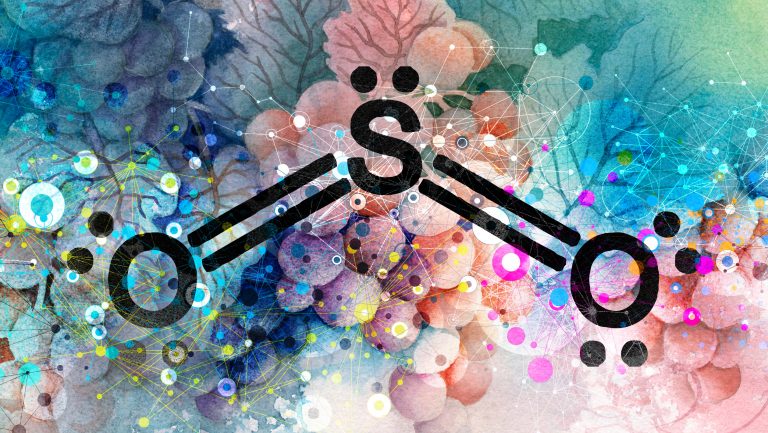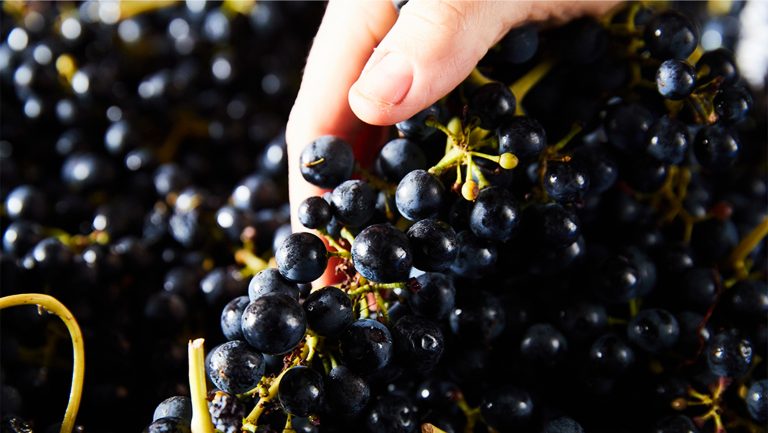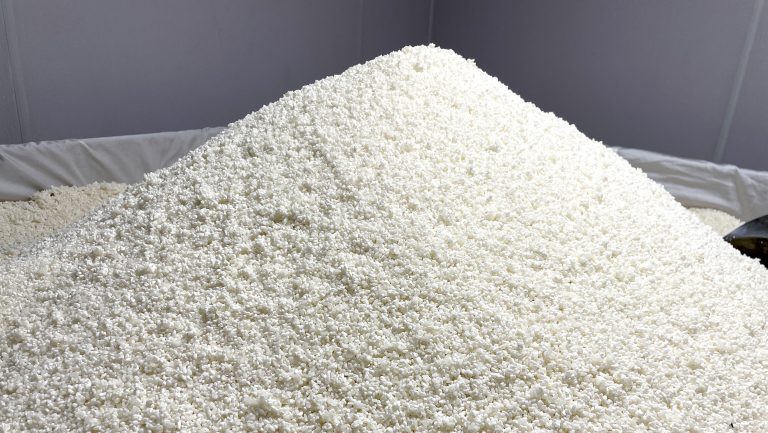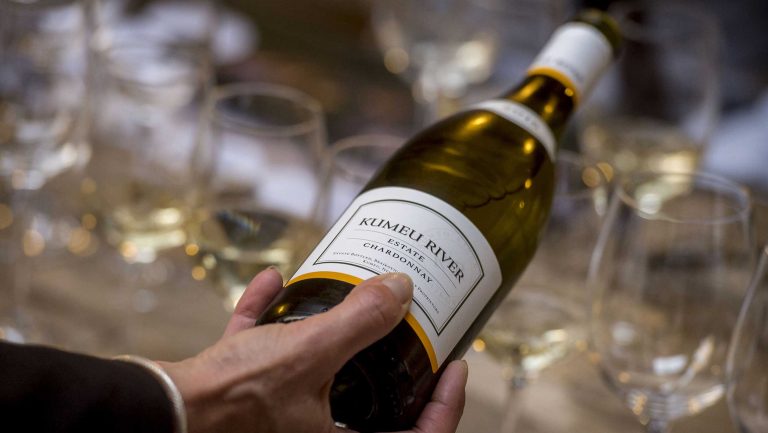The emergence of natural wine and the strong viewpoints that sometimes come with it—or against it—have generated endless arguments about sulfite additions and their effects on wine. Chemistry may be more useful than ideology for resolving those disputes, and on that front, scientific research is increasingly showing that sulfites have a very wide set of effects on wine’s aromas, mouthfeel, structure, and development in both the cellar and the bottle.
Traditionally, sulfur dioxide (also known as SO2 or sulfite) has been thought of as a relatively innocuous preservative agent, acting mainly as a barrier against oxidation and undesirable bacteria. While SO2 is effective in that manner, it also does quite a lot more, especially in the early stages of vinification, when it becomes part of numerous reactions and transformations. Indeed, sulfur, the “S” in SO2, is a highly reactive element because it has six valence electrons that enable it to chemically bond to other compounds in many different ways, contributing to the formation of a broad range of molecules.
Changing Everything
Scientists and winemakers are becoming ever more aware of the multifaceted effects of sulfur in wine chemistry. “What research is increasingly showing,” says Régis Gougeon, a professor of enology at the University of Burgundy in Dijon, France, who has been studying the subject for well over a decade, “is that changing sulfite additions—or eliminating them—means modifying the organoleptic characteristics of the wine and its whole chemical profile.”

Don’t miss the latest drinks industry news and insights. Sign up for our award-winning newsletters and get insider intel, resources, and trends delivered to your inbox every week.
Using or eschewing SO2 at various stages of winemaking has effects on an array of chemical compounds in wine. Phenolic compounds like tannins and anthocyanins—and the way they combine at the molecular level—are modified by the sulfite levels in fermenting or aging wine in a variety of ways that are still not fully understood. Notably, SO2 acts in combination with oxygen and/or acetaldehyde to affect color and mouthfeel.
The type and prevalence of aromatic components like esters and thiols are also affected. For instance, in Sauvignon Blanc, greater sulfite additions will favor the presence of thiols, sulfur-based compounds that provide aromas like grapefruit and passion fruit, especially if the wines are vinified using a reductive approach—such as in stainless steel tanks, with very limited contact with oxygen. Winemaking and barrel aging with little or no sulfur added, on the other hand, will sharply reduce the presence of these thiols, leading to a set of aromas that will trend more toward mineral, citrusy, or tropical notes.
The list goes on. Sulfur-related reactions will affect the formation and prevalence of many other compounds, like aldehydes, which are linked to the appearance of oxidative character; amino acids, which are involved in the development of various polyphenols and aromatic compounds; peptides and fusel alcohols; and things like hydrogen sulfide (H2S), which can produce reductive off-flavors like rotten egg, and various polysulfides. The way sulfur is present in the wine—whether bound in those various compounds or available as free SO2—also affects the way chemical reactions will develop during and after vinification.
Not only are the effects of sulfite-related decisions wide ranging but they are long lasting: Using the same grapes to make different wines with different sulfite regimens will cause the bouquet, mouthfeel, and color of each wine to differ in the short term and the long term. A study published in Analytical Chemistry in July 2015 by Gougeon and his colleagues showed that “memories” of sulfur additions persisted in Chardonnays that had undergone three different levels of sulfite additions—even after several years of bottle aging. The differences in chemical composition linked to sulfite additions persisted even as the wines evolved in bottle.
“The choices made on this front, especially at the start of the process, will lead to a completely different molecular fingerprint in the wine, and to very different trajectories for the wine’s evolution in bottle,” says Gougeon. “You’re choosing either to create a pool of antioxidants in the wine or to have wines where the oxidative processes have already taken place. The earlier the sulfite additions, the more the sulfur stays in the wine.” It’s not just that a higher concentration stays in the wine but that the SO2 lingers longer because it has been more intrinsically bound into the wine. “And there’s a kind of addictive process at work,” Gougeon continues. “Once you start adding SO2, you often need to keep adding more.” Otherwise, the sulfur will dissipate, weakening the barrier against oxidation.
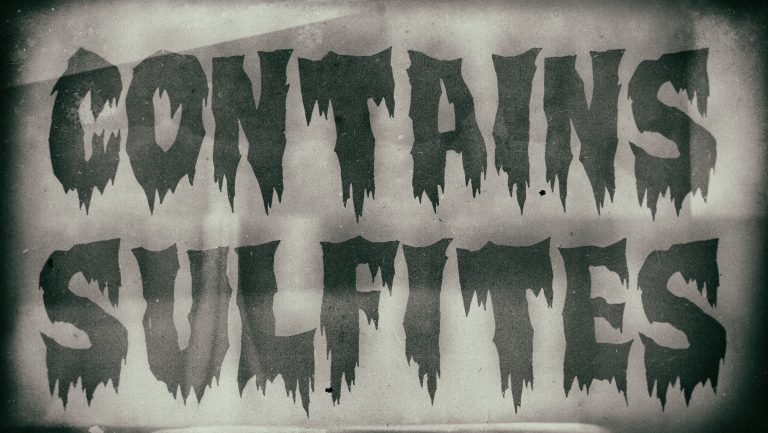
What We Talk About When We Talk About Sulfites
How somms and salespeople deal with the dreaded “S” word—and try to dispel the myths about sulfites in wine
Mapping Sulfur’s Effects
Over the course of the past decade, researchers have used a new method of study called metabolomics to learn more about the effects of sulfur on wines. Metabolomics combines different modes of analysis—like gas chromatography and mass spectrometry—to create an exhaustive map of the chemical landscape of a particular substance. Whereas chemical analysis most often targets specific compounds, metabolomics seeks to show every molecule, known or unknown, to create a complete picture of a particular wine. When a researcher performs this analysis before and after a substance has been exposed to, say, oxidation or sulfite additions, this untargeted, wide-range approach allows all the changes in the substance’s chemical fingerprint to be made visible, including those of compounds that haven’t been known to change—or even known to exist.
“We knew a few thousand compounds were present in wine,” says Gougeon, “but now, through metabolomics, we know there are tens of thousands, many of which have yet to be identified.” He also points out that some of these still-unknown families of chemical compounds seem to participate significantly in oxidative processes and reactions to sulfite additions, so much more remains to be learned.
For instance, a study published in Nature in January 2018 that was led by Fulvio Mattivi, a researcher at the Fondazione Edmund Mach in Trento, Italy, and a leader in the use of metabolomics in wine research, showed that compounds called flavanols and indoles, which play a role in the mouthfeel and aging characteristics of wine, are significantly affected by the use of SO2 during winemaking. This research led to the identification of several new compounds that seem to have significant effects on a wine’s character and evolution during bottle aging—notably, how tannins get smoother over time. In the paper’s conclusion, the authors recommend the reevaluation of SO2 chemistry and its effects on wine—something for which metabolomics is opening new avenues.
The Winemaker’s Point of View
On a more practical level, how do the effects of different sulfite regimens express themselves in the cellar? Some winemakers who have produced both sulfite-added and no-added-sulfur wines in parallel concur with Gougeon’s ideas about the very distinct trajectories produced by both approaches.

Matthieu Carliez, the technical director for the estates of the Vignobles JeanJean group in the Languedoc region of France, vinifies with and without sulfite additions. As the group has been turning to organic viticulture, it’s also experimenting with some no-sulfur winemaking at smaller estates, both to respond to market demand and to expand its approaches in vinification.
Carliez’s outlook is largely aligned with the results of Gougeon’s studies, particularly with regard to oxidation. “Wines that have had sulfite additions from the beginning have been protected from interaction with oxygen at all times,” he says, “whereas those that see no added sulfites fight oxygen and get used to it from the start. As a result, their longer-term resistance to oxygen tends to be greater.”
Claire Naudin, the owner and winemaker of Domaine Naudin-Ferrand in Burgundy, has seen similar results over the last 10 years. A portion of of her Pinot Noirs get crushed, destemmed, and sulfited at the crush pad, while the rest are whole-bunch fermented and foot trodden, with no sulfur added at any point of vinification or barrel aging. The former approach allows her to maintain the style traditionally associated with the domaine, while the latter is an opportunity for her to expand the range of wines and terroir expression.
“The no-sulfur wines tend to taste older when they’re young,” Naudin says. “That goes with their color, which can have a slight orange tinge—but as the wines get older, they keep showing a remarkable freshness of fruit.” Since oxygen has entered the process more actively and earlier on, aromatic traits usually linked to aging tend to emerge earlier. As a counterpoint, the wine usually remains more aromatically stable over time, since the oxidative reactions that yield those traits have already taken place.
Naudin has also noticed that sulfur has an effect on aromatics during and after fermentation, particularly in red wines. “During alcoholic fermentation, the impact is enormous,” she says. “In the no-sulfur wines, the focus is entirely on fruit, without any reductive notes—gamey, cassis, or even garlicky notes in reds. For me, the cassis notes are very much connected to sulfur additions before fermentation.” She also notices more floral notes in her unsulfured red wines, though she admits that this could result from the whole-bunch fermentation. The tannins in these wines also tend to be softer and the color lighter.
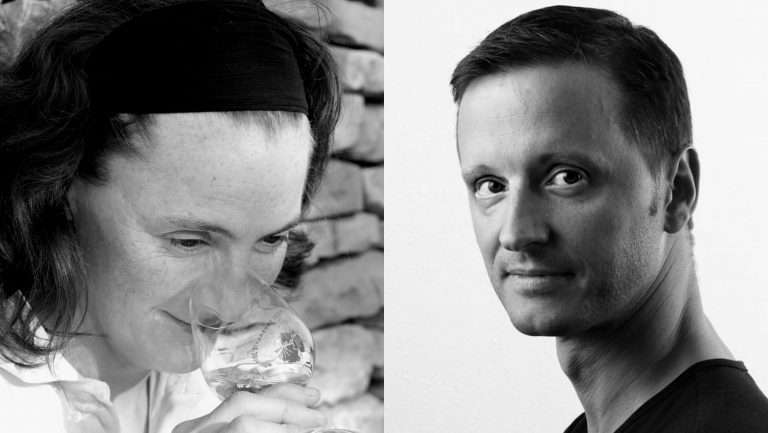
Gougeon believes that a better understanding of how sulfur affects wine style could lead winemakers toward less dogmatic approaches to sulfite management. “In some vintages, you might want to use sulfites at the beginning, and in others, at the end of the process,” he says. “What we are currently lacking is a reliable set of indicators that could tell winemakers which wines could be made without sulfur and which ones might need some. It would be better to use markers of potential stability in the wines, rather than preestablished, uniform protocols.”
If such indicators could be provided to winemakers, future decisions about sulfite additions might become more effective and more pragmatic—and less about ideology or fashionable ideas.

Dispatch
Sign up for our award-winning newsletter
Don’t miss the latest drinks industry news and insights—delivered to your inbox every week.
Rémy Charest is a journalist, writer, and translator based in Quebec City, Canada. He has been writing about wine and food since 1997 for various Canadian and American print and online publications, including Chacun son vin/WineAlign, Wine Enthusiast, Le Devoir, Le Soleil, EnRoute, Palate Press, Punch Drink, and Châtelaine, and has been a regular radio columnist for CBC/Radio-Canada. He has also judged national and international wine competitions, notably the WineAlign National Wine Awards of Canada, the TEXSOM International Wine Awards, and the International Rosé Championships.

